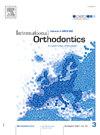不同面部类型的成人患者腭骨厚度:正畸微型计划的回顾性横断面CBCT研究
IF 1.9
Q2 DENTISTRY, ORAL SURGERY & MEDICINE
引用次数: 0
摘要
有效的正畸支抗控制在获得成功的治疗结果中起着至关重要的作用,特别是在涉及牙齿明显移动的情况下。临时锚定装置(TADs)放置在中腭区已被广泛使用,因为它们能够提供绝对的骨骼锚定而不依赖于患者的依从性。然而,解剖变量,如腭骨厚度和可能的变化,根据面部模式是治疗计划中必不可少的考虑因素。目的利用锥形束ct (cone-beam computed tomography, CBCT)评估和比较不同面部形态成人患者的腭骨厚度,以确定可能影响TAD放置的解剖学差异。材料和方法这项回顾性、横断面、观察性研究分析了2022年至2025年间获得的90份CBCT扫描,患者年龄在18至45岁之间。样本按面部类型平均分为中面组、近面组和多面组,性别和年龄分布均匀。使用3D Slicer 5.8.1软件在多个正侧参考点对腭骨厚度进行线性测量。采用Kruskal-Wallis检验进行组间比较。结果所有面部类型的腭骨厚度均由前向后逐渐减少。各组间在任何测量位置均无统计学差异(P > 0.05)。结论面部形态对腭骨厚度的影响不显著。因此,临床决定TAD的位置应优先考虑个体解剖特征而不是面部特征。本文章由计算机程序翻译,如有差异,请以英文原文为准。
Palatal bone thickness in adult patients with different facial patterns: A retrospective cross-sectional CBCT study for orthodontic miniscrew planning
Introduction
Effective orthodontic anchorage control plays a crucial role in achieving successful treatment outcomes, particularly in cases involving significant tooth movements. Temporary anchorage devices (TADs) placed in the midpalatal region have become widely used due to their ability to provide absolute skeletal anchorage without depending on patient compliance. However, anatomical variables such as palatal bone thickness and possible variations according to facial pattern are essential considerations during treatment planning.
Objective
To evaluate and compare palatal bone thickness in adult patients with different facial patterns, using cone-beam computed tomography (CBCT), with the aim of identifying possible anatomical differences that may influence TAD placement.
Material and methods
This retrospective, cross-sectional, observational study analyzed 90 CBCT scans obtained between 2022 and 2025 from patients aged 18 to 45 years. The sample was evenly divided into three groups according to facial pattern (30 mesofacial, 30 brachyfacial, and 30 dolichofacial), with equal distribution between sexes and comparable ages. Linear measurements of palatal bone thickness were performed at multiple anteroposterior and lateral reference points using the 3D Slicer 5.8.1 software. Intergroup comparison was performed with Kruskal-Wallis test.
Results
A progressive decrease in palatal bone thickness was observed from anterior to posterior regions across all facial types. No statistically significant differences were found between the groups at any measured location (P > 0.05).
Conclusion
The results suggest that facial pattern does not significantly influence palatal bone thickness in the evaluated regions. Therefore, clinical decisions regarding TAD placement should prioritize individual anatomical characteristics over facial patterns.
求助全文
通过发布文献求助,成功后即可免费获取论文全文。
去求助
来源期刊

International Orthodontics
DENTISTRY, ORAL SURGERY & MEDICINE-
CiteScore
2.50
自引率
13.30%
发文量
71
审稿时长
26 days
期刊介绍:
Une revue de référence dans le domaine de orthodontie et des disciplines frontières Your reference in dentofacial orthopedics International Orthodontics adresse aux orthodontistes, aux dentistes, aux stomatologistes, aux chirurgiens maxillo-faciaux et aux plasticiens de la face, ainsi quà leurs assistant(e)s. International Orthodontics is addressed to orthodontists, dentists, stomatologists, maxillofacial surgeons and facial plastic surgeons, as well as their assistants.
 求助内容:
求助内容: 应助结果提醒方式:
应助结果提醒方式:


